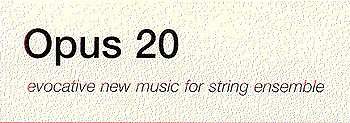
This concert under the auspices of the BMIC contrasted strongly with the inaugural concert of the series, reviewed for S&H in September a shade waspishly. The string ensemble Opus 20 (eleven players) played standing, so they were easily seen. There were no funny noises or painful 'difference tones'; they were not required to use 'extended techniques' beyond occasional judicious microtones. Indeed, the pieces chosen all allowed the players to glory in the natural sound of strings together, gorgeous in the Warehouse acoustic. If this was cutting edge music, it was not the sharp end of that spectrum, but nor was it unduly bland or reactionary.
The featured composer, with two works included , was Eero Hämmeeniemi, who discussed them entertainingly in perfect English, after thanking Scott Stroman for having championed his music and congratulating him upon pronouncing his name correctly. The Finnish Radio Orchestra under Sakari Oramo had premiered Hämmeeniemi's 3rd Symphony the previous night, so we may anticipate his music turning up in Birmingham.
We heard the first performance outside Finland of For poets and dancers, which demonstrated that this was a Finn who had not repudiated the Sibelian heritage. Sustained, plaintive music, with dark, brooding instrumentation, alternated (perhaps too many times?) with passages of heavy, thrumming rhythmic music and motivic development. Ostinato accompaniment figures were often present.
More successful was his 1997 Chamber Concerto for Violin and Strings which has, deservedly, become the most often performed work in the Finnish string orchestra repertory. The composer discussed the increasingly detailed instructions notated by contemporary composers, and his desire to free music making with an element of improvisation. The concerto has eight sections in which the score gives starting points and material for improvisation, allowing for individuality but preserving the unity and integrity of the work. A bonus for a peripatetic composer who attends many performances of his music is that interest is maintained, because performances are always different.
The concerto has four short movements, the first beginning with a free violin melody over obsessive cello pizzicato; a 'serious' scherzo-like movement; next, slow ecstatic singing music, before a more dramatic final movement, which calmed down to a passage of high harmonics, then returned to nervous rhythmic material before eventually ending quietly, with a return to the pizzicato cello which had been heard at the beginning. It was played with zest and impressive control by Bradley Creswick, and should be assured of continuing success.
Philip Cashian's short piece …in the still hours had its first London performance, a brooding nocturne which maintains a single span with a huge dynamic range and harmonic tension at the climax, after which a long solo takes the cello up into the heights, the music evaporating finally with rocking figures between violins. Very impressive.
Andrew Keeling, a former cathedral chorister who clearly knew his Tippett; is one of several composers with whom Scott Stroman and Opus 20 has a continuing, developing relationship. I enjoyed his hidden streams, which was the most 'English' piece in the programme; there is a recurring phrase tantalisingly reminiscent of the Concerto for Double String Orchestra. Keeling's piece represents interacting dimensions between chromatic and modal music, with subtle use of quartertones when they meet.
Keeling's hidden streams gives its title to Opus 20's CD on the Discipline Global Module label, recommended and reviewed separately (DGM9908). Another piece by Keeling is included, Meditatio for strings, cimbalom and harp, and its imaginative soundscape shows that this is not a composer to be judged by a single work.
Peter Grahame Woolf
 Return to:
Return to: